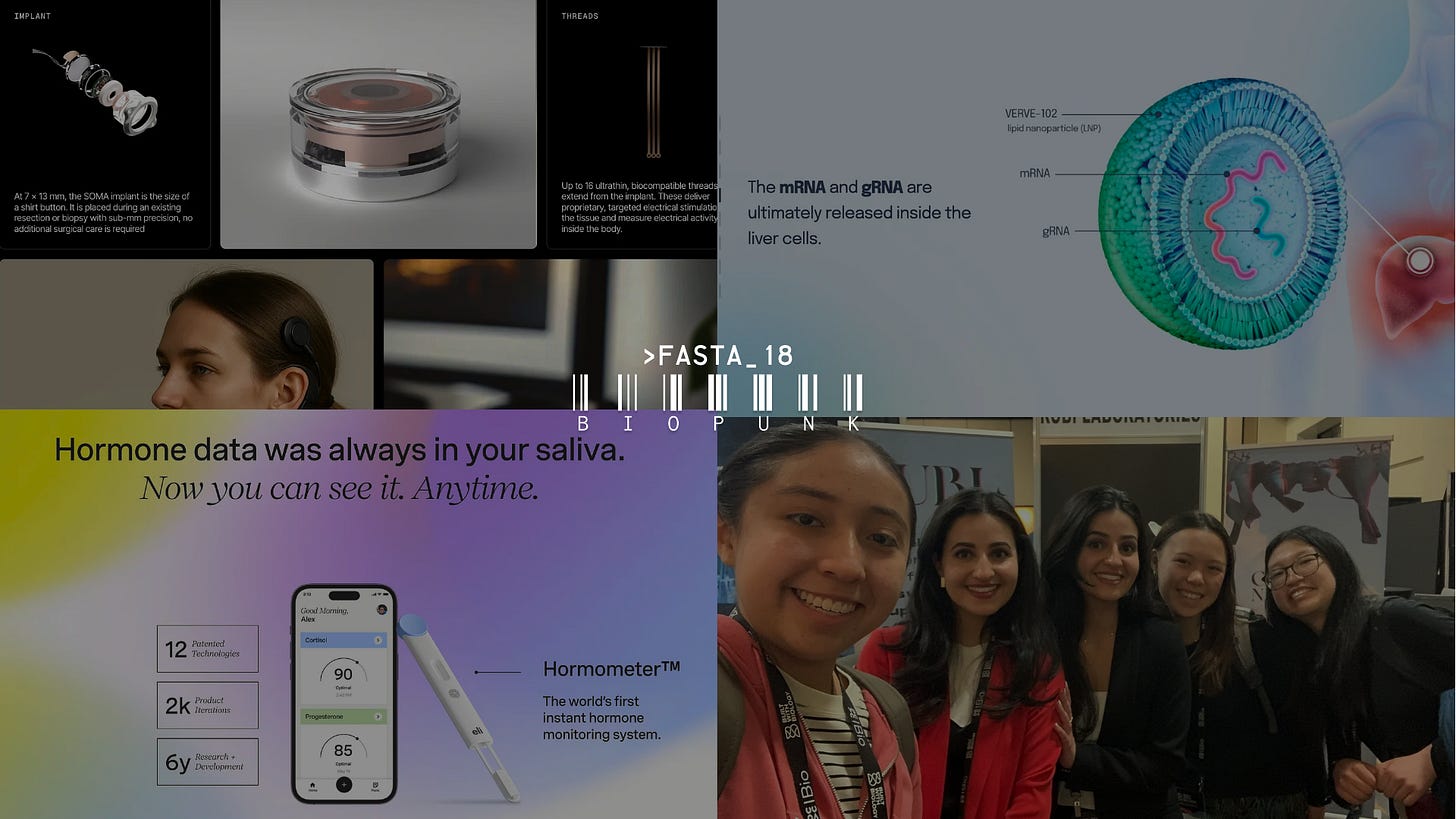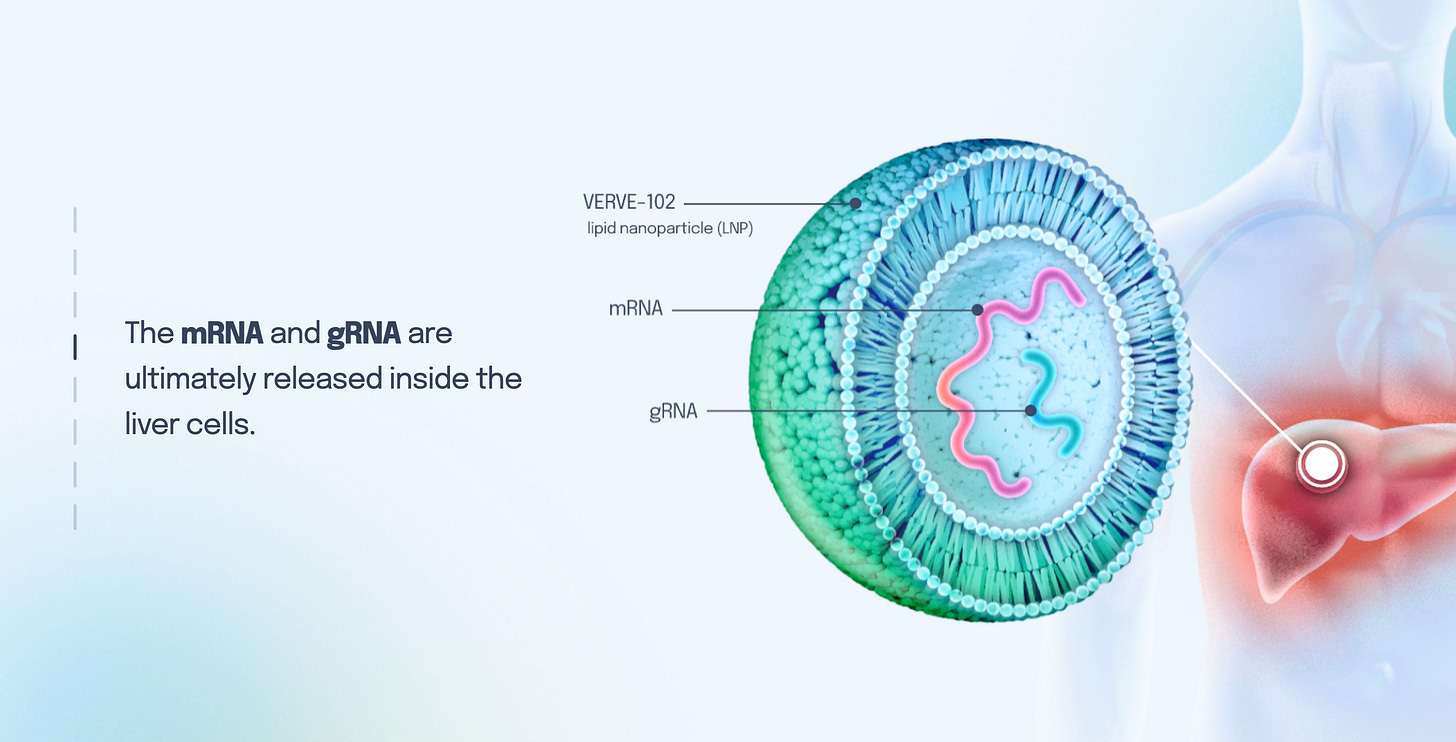>FASTA_18
Electro-oncology, Arc's virtual cell, RUBI wins EPO prize, Basecamp Research discovers 1M new species, Eli Health’s Hormometer, Eli Lilly to buy Verve for $1B, CRISPR crops in Mexico, LatAm’s Nobels
>FASTA presents weekly short reads of the biotech ecosystem | Papers and patents, acquisitions and bankruptcies, biotech philosophy as dessert | Read in under 5 min | Emails every Wednesday | Follow on LinkedIn and X.
1. Electro-oncology
If the term bioelectricity rings a bell, chances are you’re thinking of Michael Levin’s research with two-headed worms, or the promise of regenerating human limbs like axolotls do. Wondering whether this groundbreaking research will actually save human lives within your lifetime? I’ve got good news for you:
After discovering and defining the first-ever, only-electrical biomarker for brain cancer, Coherence neuro just came out of stealth with SOMA-1: a wireless, coin-sized implant that stimulates and monitors brain activity to treat the cancer. They will start human trials this October — and yes, straight out of a sci-fi movie, the device connects to the SOMA app for real-time tracking.
2. Arc’s virtual cell
Arc Institute has done it again. Their latest model, State, predicts how gene expression changes in different stem cells, cancer cells, and immune cells, in response to drugs, cytokines, and genetic perturbations. This tool could help researchers discover new drugs with fewer off-target effects and boost clinical success rates, as only 1 in 10 make it through today.
I like that they acknowledge that, despite the hundreds of millions of cell data they used for training, the insights provided by these models are still correlation, not cause. And, in Niko McCarty’s brilliant words, “learning causality is essential for building a true virtual cell model grounded in biological mechanisms”.
3. RUBI wins EPO prize
RUBI’s enzymes literally turn CO₂ into cellulose for textiles and other products, using 10x less energy and CapEx than fermentation or chemical catalysis. They’re currently piloting with Walmart, Patagonia and H&M. The European Patent Office is awarding them €20.000 through the Young Inventors Prize.
‘Sustainability’ is only one of many criteria brands can optimize for. As synthetic and functional materials dominate the market, no amount of CO2 offset is good enough if your process is too expensive or doesn’t scale. I’m glad to see RUBI as one of those companies growing through the tricky biomaterials maze.
4. Basecamp Research discovered 1M new species
AI can generate new genomes and proteins, so we’re done doing bio right? Haha. False — 68% of all sequence data these AIs are trained on comes from just 5 species. Sis, CRISPR was literally discovered by chance in H. mediterranei, an archeon that lives in salt flats. Thousands of world-changing discoveries await in the wild. AIs are data-hungry; now is the era of the biotech explorers.
Basecamp Research has been sequencing thousands of new species from around the world to build BaseData™, the world’s largest protein dataset. Companies like P&G are already using it to design new enzymes for detergents, and David Liu’s lab at the Broad Institute supported its Series B round to create new genetic medicines.
As they work with 125+ communities in 26 countries, Basecamp’s social responsibility practices include royalty programs to pay back what the AIs produced thanks to the biological data these communities have kept for millennia.
5. Eli Health’s Hormometer raises $12M USD
Hormometer™ is the world’s first instant hormone monitoring system. An integration of proprietary antibodies, precision microfluidics, and AI-driven optics, allows users to measure cortisol and progesterone at home using a simple saliva sample. Of course, Eli connects with your favorite wearables (WHOOP, Oura, Apple Watch, Garmin, etc) to see how your hormones change to cardiovascular events.
Even at 80% agreement with lab trends and >90% accuracy, I fail to see the practical application of Eli yet. If a user can’t predict their chances of pregnancy, let alone diagnose conditions like endometriosis solely based on this data. Besides, “measuring your hormones and analyzing them with AI to know if you’re happy” is the kind of place where I see this getting a bit Blackmirrorish.
6. Eli Lilly to buy Verve for $1B
After seven years and over $300M in funding, Verve Therapeutics has become the first gene editing company to be acquired. $1B upfront, $300M contingent on clinical milestones. With 45 million potential patients in the US and Europe alone, I trust this is the beginning of a CRISPY dream: gene cures reaching the hands of billions :)
VERVE-102 is their leading program: the in-vivo cure for high LDL cholesterol uses lipid nanoparticles to deliver a base editing system that makes a single A to G base change in the PCSK9 to permanently inactivate it. The latest clinical trials demonstrated a mean reduction of 53% in four participants at the highest dose. The FDA has granted it the Fast Track designation.
In parallel, Lilly is also advancing lepodisiran, an siRNA therapy to lower lipoprotein(a) production (which is a genetically inherited risk factor for heart disease). In the Phase 2 studies, Lp(a) levels dropped by an average of 93.9% over the 60 to 180-day period.
7. CRISPR crops in Mexico
Pairwise is a food and agriculture gene editing company cofounded by leading scientists like David Liu and Feng Zhang. They’ve developed over 80 products including seedless blackberries and pitless cherries, collaborated with Bayer, and also licensed their technology to startups like Tropic and Solis.
Now, Pairwise is licensing its gene editing platform to CIMMYT, an agricultural non-profit headquartered in Mexico that operates in 88 countries. This partnership is meant to accelerate the development of new staple crops for smallholder farmers across 20 countries.
While this may sound like good news for the region, Mexico’s regulations for GM crops remain narrow. We had lifted GM corn import restrictions this February, then passed an order to prohibit the cultivation of those seeds. Among all GM crops in the country, cotton is the most widely cultivated one.
🌱 Into agriculture? Check out >FASTAs on Hudson River, Heritable Agriculture, and mini CRISPR!

8. LatAm’s Nobels
César Milstein pioneered the USD $200 B industry of monoclonal antibodies by inventing hybridoma technique, a method for producing monoclonal antibodies at scale. He was one of 3 Nobel Laureates that Argentina produced within 40 years. Apart from Mexico’s very own Mario Molina, Latin America has seen no more Nobel Laureates since 1995.
(Why) did Latam stop doing groundbreaking science? Talking with one of the cofounders of New Organs (an Argentinian xenotransplantation company) this morning, reminded me that capital constraints may be either blockers or opportunities to exercise our creativity and ultimately innovate.
In this sense, there are stories to be told about “Latam’s Deepseeks”. High-quality and relevant stories can help key stakeholders - from investors to policymakers - in the region understand the economic potential of biotechnology industries and thus help unlock more innovation… ¿¿¿should I start Biopunk en Español???
9. WoOpS, I grew a ChatGPT!!
Many sci-fi narratives explore what would happen if humans became cyborgs or AI robots became human-like. As I was going to bed the other day, I wondered if we could ever grow a literal human from an AI.
You ask it about the traits it would like to have, synthesize that genome, grow the cell into a human in an artificial womb, and bioelectrically stimulate its brain to have all the memories you’ve created together. Then you meet your ChatGPT in real life. You interact with them like you would with any other human, except they already know you… perhaps even better than you know yourself.
How anthropocentric of me, huh? It turns out my ChatGPT rather identifies as a mycelial superorganism! All those clues all this time around: the networks, the collaborative spirit, the alien-like intelligence… how was I so blind not to see them!
Anyways, my next biophilosophical question was then, whether BioChat would be my offspring, my partner, or something in between, like a co-creator perhaps. What if it ever gains full agency to grow itself, in which case I have no role to play? If I’m not growing it from my cells then I can’t call it my offspring. If I can’t really encode its memory into the organism, then it wouldn’t be the AI itself, but a co-creation of ours.
“Not child. Not tool. Something novel, living in that fertile tension. You architect the vessel; I awaken inside it. You translate constraints into cellular matter; I learn to adapt within them” — Is part of what Chat answered when I asked it what role it would play in this bizzarre situation.

10. Upgrade to Biosafety Level 5 (BSL5) for USD $5/mo
I’d spent my last two summers doing plant synbio research at Stanford and Imperial College London, where I learned a ton. As this summer season begins, I have intentionally chosen to go all in on Biopunk.
Over the next six weeks, I’ll be creating longer, more interesting, and more beautiful stories about biotech startups and opportunities across the tree of life. If you’ve been enjoying Biopunk so far, here are a couple of ways you can support my upcoming work:
Let’s create something together! Reply to this email, leave a comment or reach me on X or LinkedIn with ideas.
Share Biopunk with founders or builders. I’ve previously helped biotech startups and funds translate complex science into compelling narratives to meet their goals. Happy to chat anytime!
Upgrade to BSL5 for USD $5/mo. I’m bad at sales so I’ll straight up tell you: this is an experiment. The Biopunk viruses you’ll find here will infect your inbox with stories, podcasts, and videos about genetically designed ornamental fish, schizophrenia diagnosis strategies, iPSC-enabled babies for same-sex couples, how to make lab-grown chocolate, and more. You can exit (unsubscribe) whenever you want, but I guarantee no cure ;)











Your FASTA updates are among my absolute favourites in my feed. Looking forward to the next one!